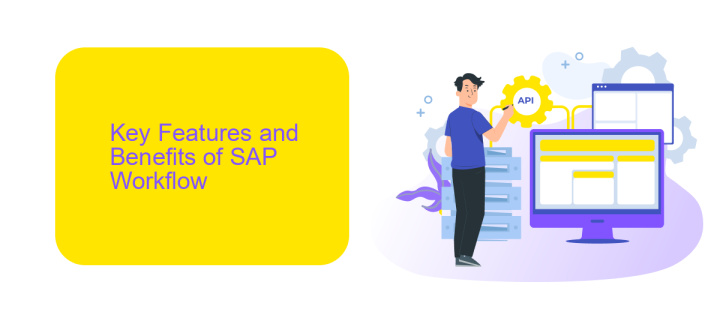SAP Workflow Business Process Automation
SAP Workflow Business Process Automation is a transformative solution designed to streamline and optimize complex business processes. By automating routine tasks and integrating seamlessly with existing SAP systems, it enhances efficiency, reduces errors, and accelerates decision-making. This article explores the key features, benefits, and implementation strategies of SAP Workflow, demonstrating how it can revolutionize business operations.
Introduction to SAP Workflow
SAP Workflow is an essential component of the SAP system that enables the automation of business processes. By streamlining tasks and approvals, it ensures that the right work is done by the right people at the right time. This not only increases efficiency but also reduces the likelihood of errors and delays in business operations.
- Automates repetitive tasks
- Ensures timely approvals
- Improves process transparency
- Reduces operational costs
- Integrates with other SAP modules
One of the key benefits of SAP Workflow is its ability to integrate with various external services, such as ApiX-Drive. This service facilitates seamless integration with multiple applications without the need for complex coding. By leveraging ApiX-Drive, businesses can enhance their SAP Workflow capabilities, ensuring smoother data flow and more efficient process management across different platforms.
Key Features and Benefits of SAP Workflow

SAP Workflow offers a comprehensive solution for automating business processes, significantly enhancing efficiency and accuracy. One of its key features is the ability to design, execute, and monitor workflows with minimal coding, making it accessible to users with varying technical expertise. The system ensures seamless integration with other SAP modules, allowing for a unified and streamlined business operation. Furthermore, SAP Workflow supports real-time data processing, enabling businesses to make informed decisions swiftly.
Another significant benefit is the flexibility and scalability of SAP Workflow. It can be customized to meet the specific needs of any organization, regardless of size or industry. The platform also supports integration with external services like ApiX-Drive, which simplifies the process of connecting SAP Workflow with various third-party applications. This capability allows businesses to automate and optimize their operations further. Additionally, SAP Workflow includes robust monitoring and reporting tools, providing valuable insights into process performance and helping identify areas for improvement.
How SAP Workflow Works

SAP Workflow is a robust tool designed to automate and streamline business processes, enhancing efficiency and accuracy within an organization. It allows users to define and manage workflows that automate repetitive tasks, ensuring that each step in a process is executed correctly and timely.
- Design: Users can create workflows using a graphical interface, defining each step and the conditions under which they should be executed.
- Integration: SAP Workflow integrates seamlessly with other SAP modules and third-party applications. Tools like ApiX-Drive can be used to facilitate these integrations, ensuring data flows smoothly between systems.
- Execution: Once a workflow is defined, it can be triggered automatically or manually, executing the predefined steps and notifying relevant stakeholders as needed.
- Monitoring: The system provides real-time monitoring and reporting capabilities, allowing users to track the progress of workflows and identify any bottlenecks or issues.
By leveraging SAP Workflow, organizations can reduce manual intervention, minimize errors, and ensure compliance with internal and external regulations. The integration capabilities with services like ApiX-Drive further enhance the system's flexibility, making it easier to connect various business applications and automate complex processes.
Use Cases for SAP Workflow

SAP Workflow provides robust solutions for automating business processes across various industries. By utilizing SAP Workflow, organizations can streamline their operations, reduce manual errors, and ensure compliance with internal and external regulations.
One of the key use cases for SAP Workflow is in the area of financial approvals. Automating approval workflows ensures that financial transactions are reviewed and authorized by the appropriate personnel, reducing the risk of fraud and improving the speed of financial operations.
- Automated Financial Approvals
- Employee Onboarding and Offboarding
- Purchase Order Processing
- Customer Service Request Management
- Document Management and Compliance
Integrating SAP Workflow with other business systems can further enhance its capabilities. Services like ApiX-Drive facilitate seamless integration between SAP Workflow and various third-party applications, enabling real-time data exchange and process automation. This ensures that workflows are not only efficient but also adaptive to the changing business environment.


Conclusion and Key Takeaways
SAP Workflow Business Process Automation offers a robust framework for streamlining and optimizing business processes. By leveraging SAP's powerful tools, organizations can achieve greater efficiency, reduce manual errors, and enhance overall productivity. The automation capabilities enable seamless integration of various business functions, ensuring that workflows are executed smoothly and consistently.
In addition, integrating third-party services like ApiX-Drive can further enhance the capabilities of SAP Workflow. ApiX-Drive facilitates easy and efficient integration with numerous applications and services, allowing for a more cohesive and automated workflow environment. By utilizing such integrations, businesses can achieve a higher level of automation, ultimately leading to improved operational performance and a significant reduction in manual intervention.
FAQ
What is SAP Workflow Business Process Automation?
How can SAP Workflow Business Process Automation benefit my business?
Can SAP Workflow integrate with other systems?
What types of processes can be automated using SAP Workflow?
Is it difficult to set up SAP Workflow Business Process Automation?
Routine tasks take a lot of time from employees? Do they burn out, do not have enough working day for the main duties and important things? Do you understand that the only way out of this situation in modern realities is automation? Try Apix-Drive for free and make sure that the online connector in 5 minutes of setting up integration will remove a significant part of the routine from your life and free up time for you and your employees.

